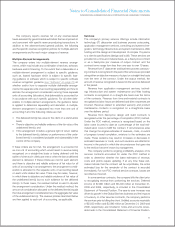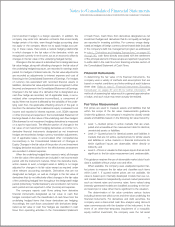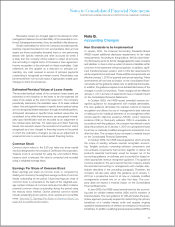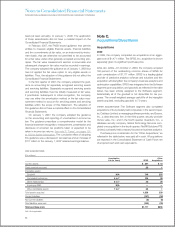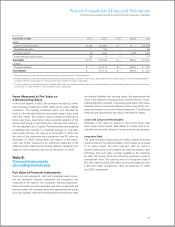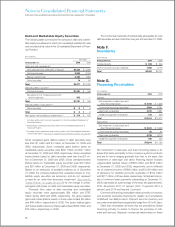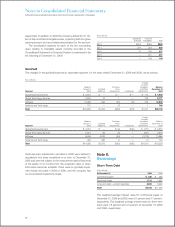IBM 2009 Annual Report Download - page 83
Download and view the complete annual report
Please find page 83 of the 2009 IBM annual report below. You can navigate through the pages in the report by either clicking on the pages listed below, or by using the keyword search tool below to find specific information within the annual report.
Notes to Consolidated Financial Statements
INTERNATIONAL BUSINESS MACHINES CORPORATION AND SUBSIDIARY COMPANIES
In December 2007, the FASB issued new guidance on non-
controlling interests in consolidated financial statements. This
guidance requires that the noncontrolling interest in the equity of
a subsidiary be accounted for and reported as equity, provides
revised guidance on the treatment of net income and losses
attributable to the noncontrolling interest and changes in owner-
ship interests in a subsidiary and requires additional disclosures
that identify and distinguish between the interests of the con-
trolling and noncontrolling owners. Pursuant to the transition
provisions, the company adopted this new guidance on January
1, 2009 via retrospective application of the presentation and
disclosure requirements. Noncontrolling interests of $119 million
at January 1, 2009, $145 million at January 1, 2008 and $129
million at January 1, 2007 were reclassified from the Liabilities
section to the Equity section in the Consolidated Statement of
Financial Position.
Noncontrolling interest amounts in income of $5 million, $14
million and $17 million, net of tax, for the years ended December
31, 2009, December 31, 2008 and December 31, 2007, respec-
tively, are not presented separately in the Consolidated Statement
of Earnings due to immateriality, but are reflected within the other
(income) and expense line item. Additionally, changes to noncon-
trolling interests in the Consolidated Statement of Changes in
Equity were $(1) million, $(26) million and $16 million for the years
ended December 31, 2009, December 31, 2008 and December
31, 2007, respectively. A separate roll forward is not presented
due to immateriality.
In March 2008, the FASB issued new disclosure requirements
regarding derivative instruments and hedging activities. Entities
must now provide enhanced disclosures on an interim and
annual basis regarding how and why the entity uses derivatives;
how derivatives and related hedged items are accounted for,
and how derivatives and related hedged items affect the entity’s
financial position, financial results and cash flow. Pursuant to
the transition provisions, the company adopted these new
requirements on January 1, 2009. The required disclosures are
presented in note L, “Derivatives and Hedging Transactions,” on
pages 92 through 96 on a prospective basis. These new require-
ments did not impact the consolidated financial results as they
relate only to additional disclosures.
In June 2008, the FASB issued guidance in determining
whether instruments granted in share-based payment transac-
tions are participating securities. The guidance became effective
on January 1, 2009 via retrospective application. According to
the new guidance, unvested share-based payment awards that
contain non-forfeitable rights to dividends or dividend equiva-
lents are participating securities and, therefore, are included in
computing earnings per share (EPS) pursuant to the two-class
method. The two-class method determines EPS for each class
of common stock and participating securities according to divi-
dends or dividend equivalents and their respective participation
rights in undistributed earnings. Restricted Stock Units (RSUs)
granted to employees prior to December 31, 2007 are considered
participating securities as they receive non-forfeitable dividend
equivalents at the same rate as common stock. RSUs granted
after December 31, 2007 do not receive dividend equivalents
and are not considered participating securities. The company
retrospectively adopted this guidance on January 1, 2009. The
impact of adoption decreased previously reported diluted EPS
by $0.04 for the year ended December 31, 2008 and by $0.03
for the year ended December 31, 2007. Previously reported
basic EPS decreased by $0.05 for the year ended December
31, 2008 and by $0.05 for the year ended December 31, 2007.
In November 2008, the FASB issued guidance on accounting
for defensive intangible assets. A defensive intangible asset is an
asset acquired in a business combination or in an asset acquisi-
tion that an entity does not intend to actively use. According to
the guidance, defensive intangible assets are considered to be a
separate unit of account and valued based on their highest and
best use from the perspective of an external market participant.
The company adopted this guidance on January 1, 2009, and
there was no impact upon adoption.
In December 2008, the FASB issued guidance regard-
ing employers’ disclosures about postretirement benefit plan
assets. This guidance requires more detailed disclosures about
the fair value measurements of employers’ plan assets includ-
ing: (a) investment policies and strategies; (b) major categories
of plan assets; (c) information about valuation techniques and
inputs to those techniques, including the fair value hierarchy
classifications (as defined in the Codification) of the major cat-
egories of plan assets; (d) the effects of fair value measurements
using significant unobservable inputs (Level 3) on changes in
plan assets; and (e) significant concentrations of risk within plan
assets. The disclosures are required annually and have been
included in the December 31, 2009 Consolidated Financial State-
ments. See note U “Retirement-Related Benefits” on pages 109
through 121 for further information. There was no impact on
the consolidated financial results as the guidance relates only to
additional disclosures.
In September 2006, the FASB issued guidance that defines
fair value, establishes a framework for measuring fair value and
expands disclosures about fair value measurements; however,
it does not require any new fair value measurements. This
guidance became effective January 1, 2008 and was applied
prospectively to fair value measurements and disclosures of (a)
financial assets and financial liabilities and (b) nonfinancial assets
and nonfinancial liabilities which are recognized or disclosed at
fair value in the financial statements on a recurring basis (at least
annually). The application of this guidance did not have a mate-
rial effect on the Consolidated Financial Statements. See note D,
“Fair Value,” on pages 86 and 87 for additional information.
In February 2008, the FASB issued two amendments to
the fair value guidance described above. The first amendment
removed leasing from the scope of the fair value guidance. The
second amendment delayed the effective date regarding fair
value measurements and disclosures of nonfinancial assets
and nonfinancial liabilities, except those that are recognized or
disclosed at fair value in the financial statements on a recurring
81


